What is a centrifuge?
Centrifuges are common laboratory devices that separate components of a liquid sample based on density by spinning the sample at high speed. As the centrifuge spins, it generates a strong centrifugal force. This force pushes denser particles to the bottom or sides of the container, while lighter particles remain closer to the center. While this process seems straightforward, different types of centrifugation provide different results.

Centrifuge technology has come a long way since Benjamin Robins introduced the whirling arm apparatus in 1707. In 1864, Antonin Prandtl proposed using a dairy centrifuge to separate cream from milk, and in 1875, his brother Alexander Prandtl demonstrated a working butterfat extraction machine.
In 1869, Friedrich Miescher used centrifugal force to isolate nucleic acids, a breakthrough that led to the discovery of DNA[1]. Today, centrifuges range from simple clinical devices to advanced ultracentrifuges capable of producing forces over a million times that of gravity[2].
There are a lot of reasons why you may need to use this process, but it may not be clear which type of centrifuge is best for the job. That’s why in this article we will focus on clarifying the answer to that question.
What do centrifuges consist of?
Most types of centrifuges are also composed of many different parts - motor, rotor, safety lid, control panel, a refrigeration system (in temperature-controlled models) and many others:

|
Part |
Function |
|
Rotor |
Holds the sample tubes and spins them to create centrifugal force |
|
Motor |
Powers the rotor and controls its speed |
|
Rotor Chamber |
Encloses space where the rotor spins and protects the user and controls airflow |
|
Lid |
Covers the rotor chamber for safety and stability |
|
Tube Holders/Swing Buckets |
Attaches to the rotor to hold sample tubes securely |
|
Control Panel/Display |
Allows the user to set spin speed, time, and other settings |
|
Brake System |
Slows and stops the rotor after the run is complete |
|
Safety Lock |
Prevents the lid from opening while the rotor is spinning |
|
Sensors |
Monitor speed, temperature, and balance to maintain safe operation |
|
Housing/Frame |
Supports all components and provides physical protection |
How Do Centrifuges Work?
One-way centrifuges are used is to quicken natural, gravity-driven settling processes. This is achieved by using centrifugal force to rapidly separate the components. Without a centrifuge, particles would take hours or days to settle under normal gravity. As a result, centrifuge usage in lab settings can reduce the rate of delayed test results by 3.1%[3].
Other functions involve separating liquid mixtures that would not separate naturally, even after being left to sit for a long time, such as thick emulsions, blood or oil products.
Here is how that process happens.
1. Sample Preparation

The sample is placed into tubes. These tubes go into holders called rotors. According to CDC guidelines[4], proper tube selection and filling is critical for safe operation.

2. Balancing

The tubes must be balanced within the rotor to avoid uneven spinning, as improper balancing is a major cause of centrifuge accidents.
3. Spinning

Once the lid is closed, the motor spins the rotor at high speed. The speed is measured in revolutions per minute (RPM) or relative centrifugal force (RCF). As the rotor spins, centrifugal force acts on the particles inside the tubes. Modern microprocessor-controlled systems, introduced by Hettich back in 1976[1], provide precise speed control and safety features even to this day.
4. Separation by Density

Particles with greater density move to the bottom or sides of the tube. Lighter particles remain near the top or mixed into the liquid. This happens because centrifugal force pushes heavier components outward.
5. Stopping & Collecting the Result
Once spinning stops, the components are clearly separated; tubes are carefully removed and needed samples are collected. This could be either the particles themselves or the liquid free of the heavier particles.
8 Different Types of Centrifuges & How They Are Used
1. Clinical Centrifuge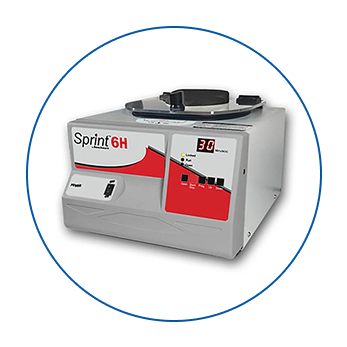
A clinical centrifuge is designed specifically for diagnostic laboratory use. It often features simple operation, moderate speed settings (typically 1,200-3,000 × g), and a rotor that accommodates blood collection tubes. Hospitals and diagnostic labs use clinical centrifuges for routine blood and urine analysis. Common applications include preparing serum or plasma from blood samples.
According to CLIA (Clinical Laboratory Improvement Amendments)[5], clinical centrifuges must meet certain requirements and often feature:
- Swing-out rotors for 5-15 mL blood collection tubes
- Quick acceleration/deceleration for stat testing
- Biocontainment features for aerosol control
2. Hematocrit Centrifuge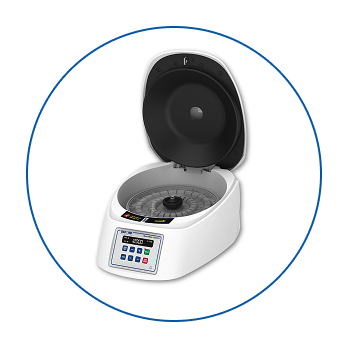
Hematocrit centrifuges are specialized units designed to spin capillary tubes filled with blood. Their primary purpose is to measure the hematocrit or red blood cell volume percentage. This technique was revolutionized by Maxwell Wintrobe in the 1930s[6], who developed the microhematocrit method used today.
Clinical settings rely on hematocrit centrifuges to quickly produce accurate hematocrit values (typically in 60-90 seconds at 11,000-12,000 RPM). This helps medical professionals diagnose conditions such as anemia or dehydration.
Modern models like the BenchMate CH24VX provide:
- Adjustable timer settings
- Built-in preset feature to make use easier
- Safety features for capillary tube containment
3. Microcentrifuge/Mini Centrifuge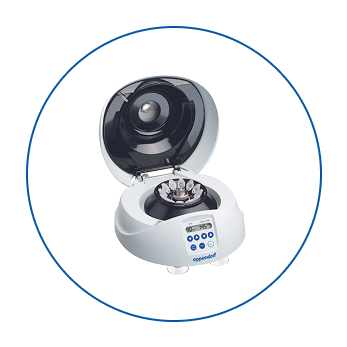
Microcentrifuges and mini centrifuges are compact units designed for small sample volumes. They typically use microcentrifuge tubes that hold 0.2 to 2.0 mL. Mini centrifuges are generally simpler and suited for quick spins or low-speed separations (up to 7,000 RPM), while microcentrifuges can reach speeds up to 21,000 RPM.
The first laboratory microcentrifuge, the Eppendorf Model 3200, was introduced in 1962 and transformed molecular biology research[7]. Laboratories use these centrifuges for:
- DNA and RNA extraction (12,000-14,000 RPM)
- Protein precipitation and analysis
- PCR reaction preparation
- Cell pelleting (1,000-5,000 RPM)
4. Refurbished Centrifuge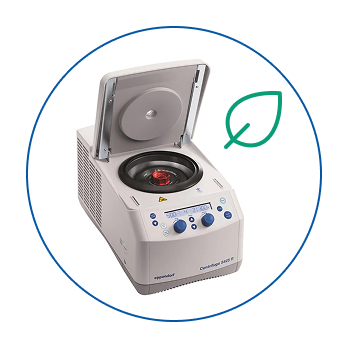
A refurbished centrifuge is a pre-owned unit that has been restored to meet original equipment standards. Refurbishment typically includes inspection, replacement of worn parts and performance testing to verify reliability.
Refurbished centrifuges are used in laboratories seeking to manage equipment costs while maintaining access to reliable, high-quality devices. Refurbished centrifuges offer:
- Cost savings of 50-90% compared to new equipment
- Manufacturer certification programs
- Warranties comparable to new equipment
- Environmental sustainability benefits
Leading manufacturers like Eppendorf and Thermo Fisher maintain dedicated refurbishment programs with comprehensive quality assurance protocols.
|
Shop For Centrifuges at Pipette.com |
||
5. Benchtop Centrifuge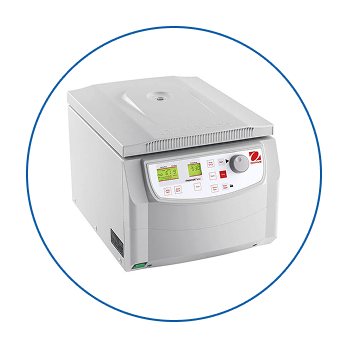
Benchtop centrifuges are versatile, compact units designed to fit on laboratory workbenches. They accommodate a wide range of tube sizes (1.5 mL to 750 mL) and sample volumes through various rotor options. Clinical, research, and industrial laboratories use these centrifuges for processing blood, urine, cell cultures and other biological materials.
Key specifications include:
- Speed range: 300-15,000 RPM
- Temperature control: -10°C to +40°C (refrigerated models)
- Multiple rotor options: fixed-angle, swing-out, microplate
- Safety features: automatic rotor recognition, imbalance detection
6. Floor-Standing Centrifuge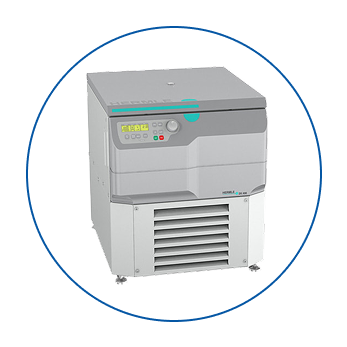
Floor-standing centrifuges are large-scale units built to handle high-volume sample processing. They deliver greater force (up to 100,000 × g) and offer large rotor capacities (up to 8 × 2,000 mL bottles). Blood banks, pharmaceutical manufacturers and industrial laboratories are most likely to use floor-standing centrifuges for large-batch sample separation, essential for:
- Large-scale cell harvesting
- Vaccine production
- Bioprocessing applications
- Blood component separation in blood banks
It is important to note that floor-standing models require specialized infrastructure, including reinforced flooring and dedicated electrical circuits.
If your lab demands high-capacity processing without compromising on precision or performance, the Hermle Z496-K Refrigerated Centrifuge is built to deliver.
7. High-Speed Centrifuge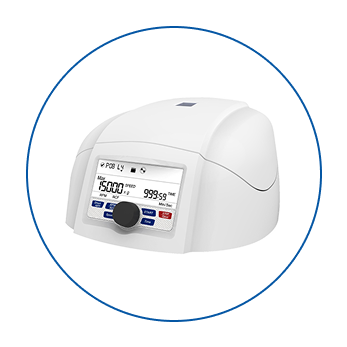
High-speed centrifuges bridge the gap between standard benchtop models and ultracentrifuges. They operate at speeds between 15,000 and 30,000 RPM, generating forces up to 110,500 × g and serve cell biology and microbiology labs that need medium-to-high centrifugal force - and Benchmate C1215V is a prime example.
High-speed centrifugation is critical for preparing samples for downstream applications like mass spectrometry and others like:
- Subcellular fractionation
- Virus concentration
- Protein purification
- Bacterial cell harvesting
8. Ultracentrifuge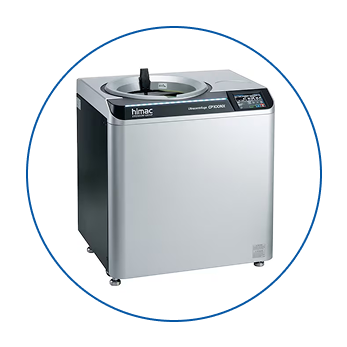
An ultracentrifuge spins samples at very high maximum speeds, often exceeding 100,000 RPM and generating forces over 1,000,000 × g. Ultracentrifuges are used in molecular biology, virology and nanotechnology. Researchers rely on them to isolate subcellular components and to purify macromolecules with high precision.
This technology earned Theodor Svedberg the 1926 Nobel Prize in Chemistry for proving that proteins are macromolecules[8]. Ultracentrifuges enabled landmark discoveries like the 1958 Meselson-Stahl experiment demonstrating semiconservative DNA replication[9] or modern LOPIT-DC spatial proteomics for organelle mapping.
6 Centrifugation Types & Which Centrifuges Suit Each One
1. Differential Centrifugation
Differential centrifugation separates particles based on size and density through repeated spins at increasing speeds. Larger, heavier particles sediment first while lighter components remain mixed in the liquid portion of a sample and can be further processed. This technique is ideal for isolating organelles, cells and macromolecules from complex mixtures.
Laboratories generally use ultracentrifuges, high-speed centrifuges and benchtop centrifuges for this process, with specific protocols varying by application.
2. Hematocrit Measurement
Hematocrit measurement involves centrifuging capillary tubes of whole blood to separate red blood cells from plasma. The NIH clinical guidelines[10] specify centrifugation at 11,000-12,000 RPM for 3-5 minutes for this purpose.
Hematocrit centrifuges are specifically designed for this process. They offer precise control and quick processing, making them standard equipment in clinical laboratories meeting CLIA requirements[5].
3. Pelletization
Pelletization uses high centrifugal force to drive particles to the bottom of the tube, forming a pellet. The remaining liquid portion (supernatant) can then be removed and the pellet is resuspended or analyzed.
Microcentrifuges, mini centrifuges, benchtop centrifuges and high-speed centrifuges all perform pelletization well, depending on the sample size. This process supports DNA extraction, protein purification and cell harvesting:
- DNA precipitation: 12,000-14,000 × g for 10-15 minutes
- Cell harvesting: 300-1,000 × g for 5-10 minutes
- Protein concentration: 10,000-20,000 × g for 20-30 minutes
|
Learn About The Other Equipment Your Laboratory Might Need |
4. Sedimentation Velocity Centrifugation
Sedimentation velocity centrifugation tracks how quickly particles move under centrifugal force. It provides information on particle size distribution and interactions. This process is used in pharmaceutical development and protein characterization studies.
Ultracentrifuges equipped with analytical rotors and optical detection systems are best for sedimentation velocity experiments, providing real-time monitoring of particle movement.
5. Clarification
Clarification removes suspended solids from liquids. The process does not aim for complete separation of all particle types but instead produces a clarified liquid suitable for further processing. Industries such as wastewater treatment, beverage production and chemical processing use clarification extensively.
High-capacity floor-standing centrifuges are best suited to clarification tasks, with continuous-flow designs enabling processing of large volumes.
6. Isopycnic Centrifugation
The goal of isopycnic centrifugation (also called density gradient centrifugation) is complete separation by buoyant density, not by size or shape. A sample is layered over a gradient medium (commonly cesium chloride or sucrose). During centrifugation, each particle migrates to the point where its density matches the surrounding gradient.
This method, refined during the Meselson-Stahl experiment[9], is used for purifying:
- Viruses for vaccine development
- Ribosomes for structural studies
- Exosomes for diagnostic applications
- Nucleic acids for sequencing
Ultracentrifuges are the optimal choice for isopycnic centrifugation, typically requiring 16-48 hours at 100,000-150,000 × g.
How Different Industries Use Various Centrifuge Types
|
Industry |
Centrifuge Type |
Typical Application |
|
Healthcare |
Clinical Centrifuge |
Separating components (i.e. serum, plasma) |
|
Hematocrit Centrifuge |
Measuring blood cell volume |
|
|
Microcentrifuge/Mini Centrifuge |
Processing small-volume biological samples |
|
|
Benchtop Centrifuge |
Routine sample separation in diagnostic labs |
|
|
Biotechnology |
High-Speed Centrifuge |
Separating cell components and purifying proteins |
|
Ultracentrifuge |
Isolating viruses, DNA, and ribosomes |
|
|
Microcentrifuge/Mini Centrifuge |
Processing genetic material and RNA purification |
|
|
Academic Research |
Benchtop Centrifuge |
General sample prep across biology and chemistry labs |
|
High-Speed Centrifuge |
Sub-cellular fractionation |
|
|
Ultracentrifuge |
Analyzing macromolecules and nanoparticles |
|
|
Environmental |
Benchtop Centrifuge |
Separating soil or water contaminants |
|
Floor-Standing Centrifuge |
Large-volume sample separation for pollutant analysis |
|
|
Food & Beverage |
Floor-Standing Centrifuge |
Clarifying juices and separating food components |
|
High-Speed Centrifuge |
Purifying additives or flavor extracts |
|
|
Industrial Manufacturing |
Floor-Standing Centrifuge |
Processing lubricants or separating oils |
|
Refurbished Centrifuge |
Cost-effective separation for general manufacturing use |
|
|
Forensics |
Clinical Centrifuge |
Separating blood samples for toxicology tests |
|
Microcentrifuge/Mini Centrifuge |
Processing trace biological evidence |
Find The Type of Centrifuge You Need at Our Store
Selecting the appropriate centrifuge requires understanding your specific application needs, sample volumes and required separation forces. From simple clinical centrifuges processing routine blood samples to sophisticated ultracentrifuges enabling groundbreaking research, each type serves distinct purposes in modern laboratories - and you can consult manufacturer application guides (like Eppendorf[11]) for detailed protocols specific for your applications.
If you know which centrifuge your laboratory needs, your next step is finding a reliable supplier who sells it. Pipette.com can help. We offer a wide range of centrifuges built to meet various needs. We are a 17025 ISO-accredited and FDA-registered facility who takes the time to verify that all equipment we sell can meet these high standards.
Start shopping today!
Frequently Asked Questions
What is a centrifuge used for?
A centrifuge separates components of a liquid sample based on density by spinning at high speed. It’s used in clinical testing, research, biotechnology, manufacturing, and more.
How does a centrifuge work?
The rotor spins tubes containing the sample, creating centrifugal force. Heavier particles move outward, while lighter ones remain closer to the center.
What are the main parts of a centrifuge?
Key components include a rotor, motor, rotor chamber, lid, control panel, tube holders, brake system, safety lock, sensors, and housing.
Why is balancing important in centrifugation?
Unbalanced rotors cause vibrations, damage equipment, and can be hazardous. Tubes must be placed symmetrically with equal weight.
What speed should I use for my samples?
It depends on your application and sample type. Speed is set in RPM (revolutions per minute) or RCF (relative centrifugal force). Always follow your protocol.
What types of centrifuges are there?
Common types include clinical, hematocrit, microcentrifuge, benchtop, floor-standing, high-speed, and ultracentrifuge models.
Which centrifuge is best for DNA or RNA work?
Microcentrifuges or high-speed centrifuges are typically used for nucleic acid extraction and purification.
Can I buy refurbished centrifuges?
Yes, refurbished models can offer cost savings (50–90% less than new) while meeting original quality standards.
How do I maintain a centrifuge?
Clean rotors regularly, check for corrosion, inspect seals, follow the manufacturer’s maintenance schedule, and store in a dry, dust-free space.
Is centrifuge use regulated in clinical labs?
Yes. In the U.S., the CLIA regulations specify performance and safety standards for clinical centrifuges.
Reference List:
- Lab Manager, "Evolution of the Lab Centrifuge"
- Beckman Coulter, "An Introduction to Ultracentrifugation"
- Laboratory Medicine, "Preparation of a Quality Sample: Effect of Centrifugation Time on Stat Clinical Chemistry Testing"
- Centers for Disease Control and Prevention, "Guidelines for Safe Work Practices in Human and Animal Medical Diagnostic Laboratories"
- Centers for Disease Control and Prevention, “Clinical Laboratory Improvement Amendments”
- National Library of Medicine, "Maxwell Myer Wintrobe: New History and a New Appreciation"
- Eppendorf, "60 years of Eppendorf Centrifuge"
- The Nobel Prize, "Theodor H.E. Svedberg Nobel Prize"
- Embryo Project Encyclopedia, "The Meselson-Stahl Experiment (1957–1958)"
- National Library of Medicine, "Hematocrit - StatPearls"
- Eppendorf, "Centrifugation Applications"

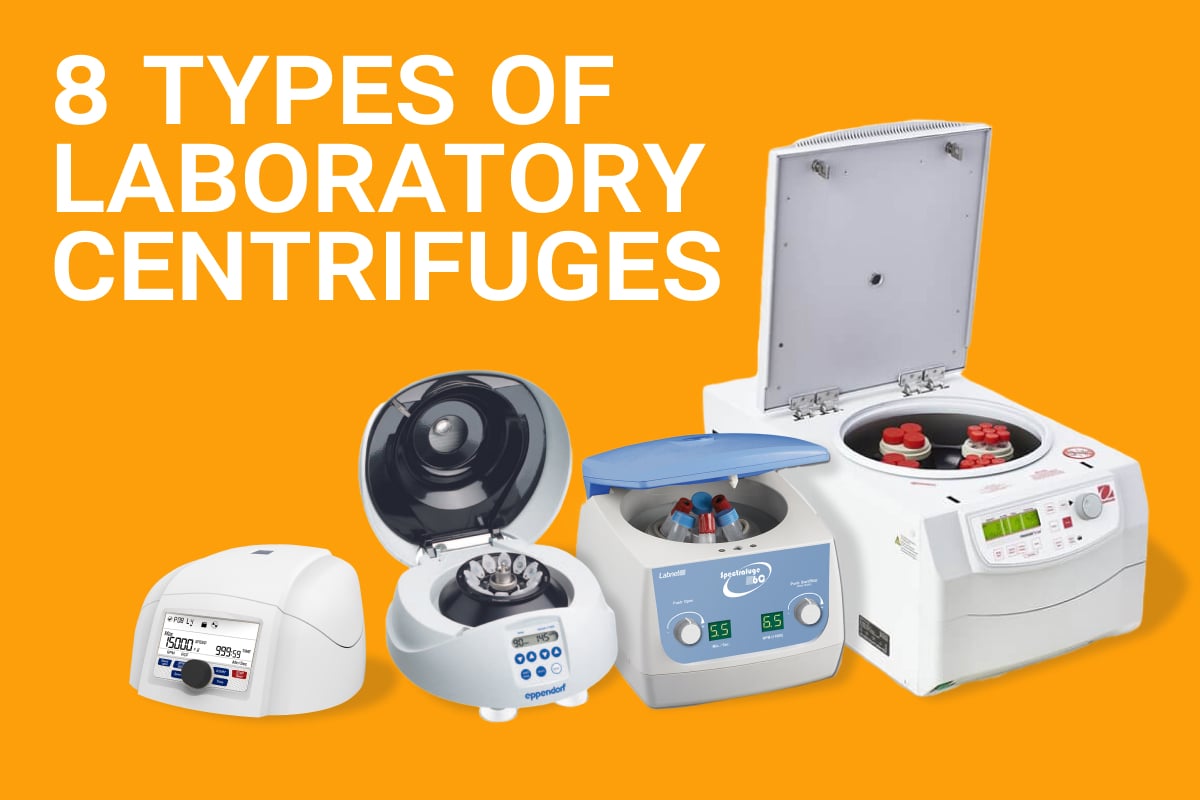
.png?width=171&height=53&name=image3%20(1).png)

